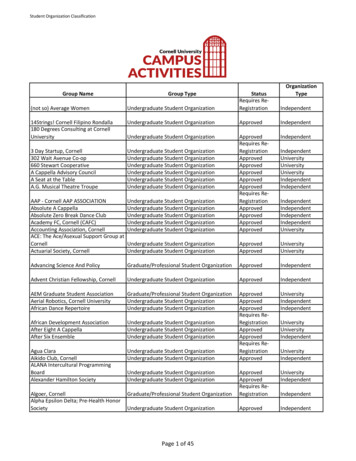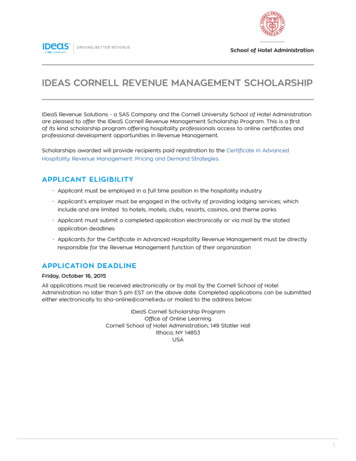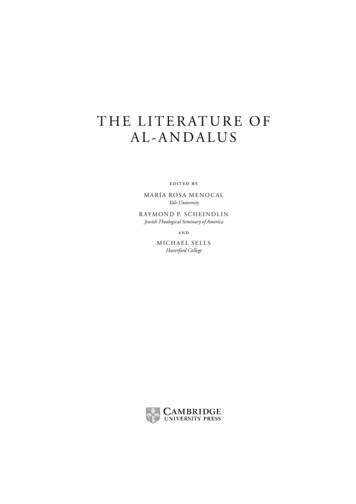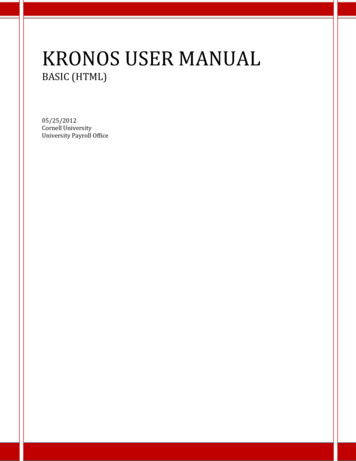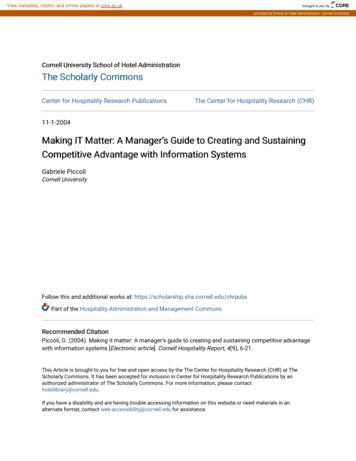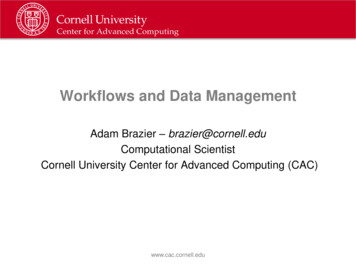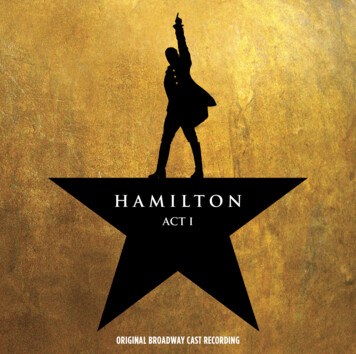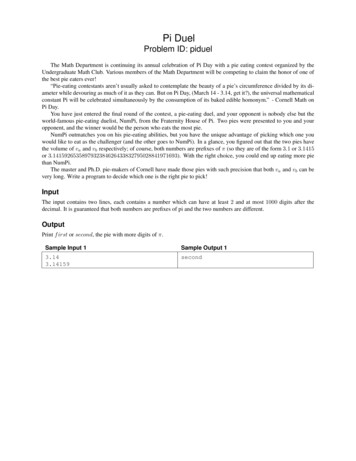
Transcription
Pi DuelProblem ID: piduelThe Math Department is continuing its annual celebration of Pi Day with a pie eating contest organized by theUndergraduate Math Club. Various members of the Math Department will be competing to claim the honor of one ofthe best pie eaters ever!“Pie-eating contestants aren’t usually asked to contemplate the beauty of a pie’s circumference divided by its diameter while devouring as much of it as they can. But on Pi Day, (March 14 - 3.14, get it?), the universal mathematicalconstant Pi will be celebrated simultaneously by the consumption of its baked edible homonym.” - Cornell Math onPi Day.You have just entered the final round of the contest, a pie-eating duel, and your opponent is nobody else but theworld-famous pie-eating duelist, NumPi, from the Fraternity House of Pi. Two pies were presented to you and youropponent, and the winner would be the person who eats the most pie.NumPi outmatches you on his pie-eating abilities, but you have the unique advantage of picking which one youwould like to eat as the challenger (and the other goes to NumPi). In a glance, you figured out that the two pies havethe volume of va and vb respectively; of course, both numbers are prefixes of π (so they are of the form 3.1 or 3.1415or 3.1415926535897932384626433832795028841971693). With the right choice, you could end up eating more piethan NumPi.The master and Ph.D. pie-makers of Cornell have made those pies with such precision that both va and vb can bevery long. Write a program to decide which one is the right pie to pick!InputThe input contains two lines, each contains a number which can have at least 2 and at most 1000 digits after thedecimal. It is guaranteed that both numbers are prefixes of pi and the two numbers are different.OutputPrint f irst or second, the pie with more digits of π.Sample Input 1Sample Output 13.143.14159second
Slope Day CountdownProblem ID: slopedaycountdownSlope Day is an annual day of celebration held at Cornell University the Thursday after the last day of undergraduate classes, and itincludes live music and catered food.Slope Day is coming, and you just can’t wait to see your favoriteartists play. You don’t want to miss a thing! To help you be thevery first person to arrive, you set up a countdown timer that showshow many seconds are there until Slope Day starts. However, as youquickly realized, displays like “314159 seconds” aren’t very intuitive. So you decide to upgrade it to a more human-readable version.The logic you have in mind can be described as follows:If there are 0 seconds left, the program should print “NOW”.If there are fewer than 60 seconds left, the program should print“s seconds” where s is the number of seconds left without leadingzeros.If there are fewer than 3600 seconds left, the program should print “m minutes s seconds” where m is thenumber of minutes left and s is the number of seconds left after m minutes.If there are fewer than 86400 seconds left, the program should print “h hours m minutes s seconds” where h,m, and s are the number of hours, minutes, and seconds left respectively.Otherwise, the program should print “d days h hours m minutes s seconds” where d represents the numberof days left and other variables the same as above.InputThe input contains single line with a single integer T , 0 T 109 , the number of seconds before Slope Day.OutputPrint a single line in the format described in the problem statement. DO NOT print extra whitespaces.Sample Input 1Sample Output 15959 secondsSample Input 2Sample Output 236031 hours 0 minutes 3 secondsSample Input 3Sample Output 30NOW
Dragon Day ParadeProblem ID: dragonparade“Every year in March, in a tradition that goes backmore than 100 years, an enormous dragon created byfirst-year architecture students parades across campus.Accompanied by AAP students in outrageous costumes,the dragon lumbers to the Arts Quad where it does battle with a phoenix created by rival engineering students.This rite of spring is one of Cornell’s best-known traditions.” - Cornell AAP on Dragon Day.This year, the students have built an enormousdragon of N segments on Campus Rd, which can be considered an infinitely long straight line. The segments arenumbered from 1 to N .As one of the organizers, you are given the challenging task of assigning the team of exactly N students toThis was 2019’s dragon. A new dragon is designed and built every year.the N segments of the dragon.Each student must be assigned to a unique segment. Student i is at the position Pi at time 0, and the studentassigned to segment j must reach position Qj to operate segment j.All students can travel at the speed of a unit of distance per second in either direction, and they move in parallelwithout interfering with one another.What is the minimum time for all students to reach their posts and start marching to the Arts Quad?For example, suppose the dragon has N 2 segments that should be on positions Q1 1865 and Q2 2012,and the students are initially at positions P1 2000 and P2 1900.There are two ways to assign students to dragon segments: Student 1 is assigned to segment 1 (and student 2 to segment 2). Student 1 will take 2000 1865 135 seconds,and student 2 will take 2012 1900 112 seconds, so the total time would be 135. Student 2 is assigned to segment 1 (and student 1 to segment 2). Student 1 will take 2012 2000 12 seconds,and student 2 will take 1900 1865 35 seconds, so the total time would be 35.Therefore, the correct solution is 35, as the second option is better.InputThe input starts with a single line containing a single integer N , (1 N 10000), the number of segments and thenumber of students.The second line contains N integers, Pi , (1 Pi 105 ), the position of the students at time 0.The third line contains N integers, Qi , (1 Qi 105 ), the required position the segments.It is NOT guaranteed that the position of the students or the required position of the segments would be given inany specific order.OutputPrint a single integer, T , the minimal time for all students to reach their assigned post for some optimal assignemnt.Sample Input 1Sample Output 122000 19001865 201235
Sample Input 2Sample Output 21100010000
Far Above Cayuga’s WaterProblem ID: abovecayuga“Far above Cayuga’s waters,With its waves of blue,Stands our noble Alma Mater,Glorious to view.”- Far Above Cayuga’s Water“Far Above Cayuga’s Waters” is Cornell University’s alma mater. The lyrics were written circa 1870 by roommatesArchibald Croswell Weeks (Class of 1872) and Wilmot Moses Smith (Class of 1874) and were set to the tune of “AnnieLisle,” a popular 1857 ballad by H. S. Thompson about a heroine dying of tuberculosis.Knowing this song well, Alice, the brave Queen-Knight, wonders what is really there far above Lake Cayuga’swater. So she looked at a satellite map and found many points of interest, such as the Herbert F. Johnson Museum ofArt, the Cornell Botanic Gardens, the Bloomberg Center of Cornell Tech, and even the new Cornell Ann S. BowersCollege of Computing and Information Science building (which is mostly occupied by the department of post-quantummachine learning). What is even more curious about this image is that she could draw many triangles out of thosepoints! Maybe triangles are what’s really there?Given N points on a 2D plane, what is the maximum number of triangles with positive area one can draw usingthose points as vertices and using each point at most once?The blue subfigure forms one triangle (note that you can’t form another triangle with the three remaining points)while the red one forms two.Two is the maximum possible number of triangles, so the answer is 2. This drawingreflects sample input 1 below.InputThe first line of the input contains a single integer N , 1 N 105 , the total number of points.Each of the following N lines contains two integers x, y, 1 x, y 109 , the coordinate of a point of interest. Theinput guarantees that all coordinates are different.OutputOutput a single integer, the maximum number of triangles one can draw under the restriction.
Sample Input 1Sample Output 1615961421352118Sample Input 2Sample Output 2812345678012345678
RBGProblem ID: rbgOne of Cornell’s new North Campus dorms will be namedin honor of the associate justice of the Supreme Court of theUnited States, Ruth Bader Ginsburg ’54. This problem is alsonamed after her.You are designing a virtual reality (VR) game simulatinga supreme court hearing. In particular, you are now creatingthe method to render the courtroom, and for that you need todecide the color of each pixel of the VR display.The courtroom can be described as a box which is Wpoints wide, L points long, and H points high. Each point isdescribed by its color in red-blue-green space “RBG” (the legislative variant of the more well-known RGB). In other words,the color of each of the W L H points will be divided in3 components (red, blue, and green). Each component will bea number between 0 and 255.For instance, the color red is defined as (255, 0, 0), while yellow is (255, 0, 255) (combination of equal parts redand green).A particular pixel to be rendered represents a box within the room. For instance, a pixel might represent the box(1, 3, 5) (3, 10, 7), which means that all points (x, y, z) with 1 x 3, 3 y 10, and 5 z 7 are representedby that pixel. A pixel should be colored with the average color of the points represented by it!For instance, if a pixel represents points with color (10, 0, 255), (50, 50, 50), and (255, 0, 0), then the pixel should, 0 50 0, 255 50 0) (105, 16, 101) (note that all divisions should be rounded down).have color ( 10 50 255333You are given the color of all the points of the courtroom and a sequence of pixels, and it’s your job to decide thecolor of each pixel.InputThe first line of the input contains three integers W, L, H, with 1 W , 1 L, 1 H and W L H 105 .Next you will receive W blocks of lines, each block will have exactly L lines, and each line will have exactly3 H integers between 0 and 255.The interpretation is that the first three numbers correspond to the colors (in RBG) of point (1, 1, 1), then point(1, 1, 2) will be given, and so far so on (until (1, 1, H), followed by (1, 2, 1) then (1, 2, 2), until (1, 2, H), . . . ). Pleasesee the samples below to understand the input format.The next line will contain a single integer Q (1 Q 105 ) with the number of pixels to be drawn.The next Q lines will contain 6 integers in x1 , y1 , z1 , x2 , y2 , z2 (with 1 x1 x2 W , 1 y1 y2 L,1 z1 z2 H) with the description of the box of points that this pixel represents (it represents a total of(x2 x1 1) (y2 y1 1) (z2 z1 1) points).OutputThe output should contain Q lines, one for each pixel.The i-th line should contain 3 integers with the color of the i-th pixel in RBG.(Read the sample inputs below for further clarification)
Sample Input 1Sample Output 11 2 30 1 23 4 56 7 89 10 1112 13 1415 16 1731 1 1 1 2 31 1 1 1 1 11 2 2 1 2 37 8 90 1 213 14 15
Pumpkin on the ClocktowerProblem ID: pumpkinclocktowerOne of the greatest mysteries in Cornell history is about a pumpkin placed atop the173-foot-tall spire of McGraw Tower in October 1997. It has since been memorializedas an ice cream flavor, “Clocktower Pumpkin,” produced by the Cornell Dairy.No one has ever figured out how the pumpkin got up there, but one hypothesis thatinvolves temporary support beams has caught our attention.A close examination of the clock tower suggested that there are N positions wherebeams can be placed.Each possible position is close to exactly one position above it (and may be closeto zero or more positions below it). Such a close position can be either the top of thetower or another possible position for a beam.In other words, if we connect each possible position to the position above it that isclose to it, we will get a tree with N 1 nodes and N edges, with the top of the toweras its root.Each support beam i would provide some steadiness value si if placed. The civilengineering department advised you that if a beam is placed, then at most 1 other beam A sixty pounds pumpkin just appeared ontop of McGraw Towerthat is close to it can be placed.To test the hypothesis of placing the pumpkin through temporary support beams,you wonder what would be the maximum possible sum of steadiness values of a proper support beam placement.Sample input 1:The first selection of beam positions has value 230 but is invalid because a beam has 3 other beams close to it.The second one is valid, and has value 120.The third one is also valid, and has value 230, which is the highest possible.InputThe first line of input contains a single integer N , 1 N 105 , the total number of possible positions. Positions arenumbered from 1 to N , and the top of the tower is numbered 0. Positions are listed in decreasing order of height. Soposition 0 is the highest (top of the tower) followed by position 1, . . .The following N lines describe the tree structure. The i-th line contains two integer pi and si (0 pi i and1 si 104 ), which are the position above i which is close to it and the steadiness of a beam placed at position irespectively.OutputOutput a single value, the maximum possible sum of steadiness values.
Sample Input 1Sample Output 160011332303040501050100Sample Input 2Sample Output 2100 100 100 100 100 100 100 100 100 100 10100
Picnic in the GorgesProblem ID: gorgepicnicOver the summer and at the beginning and end of the academic year,when Ithaca enjoys warmer weather, Cornell students are known tofind respite from the heat in the two creeks that cut across Cornell’sIthaca campus through two dramatic gorges — Cascadilla and FallCreek.Surprisingly, whenever a waterway divides in two, these twobranches never meet again. In other words, the waterfall and creeksform a tree with waterfalls as nodes and waterways as edges. Thewaterfalls are conveniently numbered from 1 to N . Two Cornell students, Hiro and Sophie, are planning a picnic in the beautiful gorgesover the weekend. Hiro will start from waterfall u and Sophie froma different waterfall v. They will each then take the shortest routealong the water to meet at a third waterfall w for lunch.They wonder whether they can meet somewhere before waterfall w and walk the rest of the way enjoying eachothers company.In case 1 above (Hiro is at u1 , Sophie at v1 , and they want to meet at w1 ), they will only meet at w1 .But in case 2 they can meet before reaching w2 (namely at the node labeled w1 ).This example corresponds to sample input 1 below.InputThe first line of the input contains a single integer N , 3 N 105 , the number of waterfalls around Cornell.The following N 1 lines describe the waterways. Each line contains two integers a, b, 1 a, b N indicatingwaterfall a and waterfall b are directly connected by a creek. The input guarantees the waterfalls and creeks form avalid tree.The N 1-th line contains a single integer Q, 1 Q 105 , the number of days when Hiro and Sophie wouldlike to have lunch.The following Q lines describes each day. Each line contains three integers u, v, w, all between 1 and N , and alldifferent describing where Hiro starts that day, where Sophie starts, and where they want to meet.OutputFor each query, output a separate line of “YES” (without quotes) if Sophie and Hiro might run into each other on theirway from u to w and v to w; output “NO” otherwise.
Sample Input 1Sample Output 17123446276NOYES3345671 42 5
The Final TouchdownProblem ID: finaltouchdownAttention: This problem is HARD! Only attempt to solve it after you are done with theother problems.Touchdown, or the Big Red Bear, is the unofficial mascot of Cornell University. It appearson the logo for Cornell Athletics and is represented in a statue erected outside Teagle Hallsince 2015.It’s the year 2021. Your team is participating in the Cornell University High SchoolProgramming Contest, and you have come this far. The only problem left between yourteam and the ultimate victory of solving all problems in the contest is this problem called“The Final Touchdown.” All you need to do is come up with some magical string, usuallyregarded as “the source code,” typing it into a text box and hitting the submit button. Almosttoo easy - except that you have no clue of what that magical string look like.Fortunately Touchdown comes to help you win the game! He gives you the followingclues: The solution you are looking for is a permutation of the numbers from 1 to N . Touchdown tells you that M of the N numbers are red (the others are white). He also tells you which are thesenumbers. Touchdown tells you a strictly increasing sequence S of K numbers between 1 and N , and he guarantees that Sis a subsequence of the solution. Furthermore, no increasing subsequences in the solution has more red numbersthan S. (Touchdown calls S a Big Red Sequence)But there could still be many such permutations. Write a program to compute the number of permutations thatsatisfy Touchdown’s description. As the number might be very large, output it modulo 109 7.InputThe first line contains three integers N, M, K, 1 N 200, 0 M min(15, N ), 1 K min(50, N ).The second line contains M integers, the numbers that are colored red.The third line contains K integers in strictly increasing order, the Big Red Sequence.OutputOutput a single integer, the number of permutations consistent with what Touchdown told you.Sample Input 1Sample Output 15 4 31 2 3 41 3 415Sample Input 2Sample Output 210 5 11 3 5 7 9530240
This was 2019's dragon. A new dragon is designed and built every year. Every year in March, in a tradition that goes back more than 100 years, an enormous dragon created by rst-year architecture students parades across campus. Accompanied by AAP students in outrageous costumes, the dragon lumbers to the Arts Quad where it does bat-
